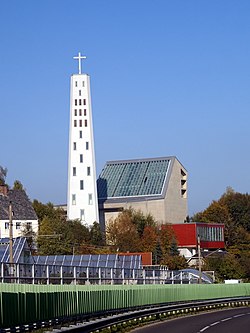|
Lenzing
Lenzing is a small town of approximately 5,000 residents, three kilometers north of Lake Attersee in Austria, It is located in the Upper Austrian part of the Salzkammergut. Lenzing's economy is partly based on tourism, but the town is much more known as an industrial site; it is the world headquarters of Lenzing AG, which is the world leader in the production of cellulose-based fiber such as viscose and Lyocell. As of 2021[update], it manufactures 17 percent of the world's cellulose fiber. HistoryThe area around Lake Attersee was inhabited as early as 6000 years ago during the Mondsee culture. This is also evidenced by finds made at Burgstall in the village of Unterachmann. From the Bronze Age, an arm spiral was found in Pichlwang, bowl head needles and fibulae in Pettighofen and an axe in Reibersdorf. Remains of buildings and coins from the Roman period were found on the present-day industrial site of the Lenzing AG, as well as clay urns in Gallaberg. Originally located in the eastern part of the Duchy of Bavaria, the area of today's Lenzing has been part of the Duchy of Austria since the 12th century. The first documentary mention dates back to 773 and concerns the village of Pichlwang. In 1350, Arnbruck appears in the land register of Michaelbeuern Abbey, in 1371 Pettighofen in the land register of the Schaunberg estate. Lenzing is first mentioned in a document in 1389. The local municipality of Lenzing was established in 1848, and in 1851 the parent municipality of Oberachmann was founded with 701 inhabitants. In 1891, the industrialist Emil Hamburger founded a paper factory in Pettighofen, a forerunner of today's Lenzing AG. Since 1918, the area has belonged to the newly founded federal state of Upper Austria. After the annexation of Austria to the German Reich in 1938 the ‘Zellwolle Lenzing AG’ was founded. In 1939, the current municipality was founded from the parent municipality of Oberachmann and by transferring territory from neighbouring municipalities. On 1 January 1940, the name of the municipality was changed to ‘Agerzell’. In November 1944, a satellite camp of the Mauthausen concentration camp was set up in the Lenzing district of Pettighofen. The up to 565 prisoners, mostly women, had to perform forced labour, particularly at Lenzinger Zellwolle AG. The camp was liberated by the US army at the beginning of May 1945. Lenzing has been a market town since 1984. Lenzing Concentration CampIn November 1944, the first transport of 500 women from Auschwitz came to Lenzing to work in the newly opened local subcamp of Mauthausen concentration camp which was located in the Lenzinger suburb of Pettighofen. Eventually 600 female prisoners, mainly Jewish women came to Lenzing from Auschwitz, and a few others came from Ravensbrück and the main camp at Mauthausen. The SS staff in the small subcamp included mainly SS men as well as a small contingent of SS women. Frau Schmidt served in her capacities as Lagerführerin, or female commandant. Her main boss was Mauthausen commandant Franz Ziereis who commanded all of the subcamps in Austria. Later Margarete Freinberger became an Oberaufseherin in the camp under Schmidt. Only one other female overseer is known today, Maria Kunik. Attitudes by the former guards was reported as arrogant and brutal, but not as horrible as in Mauthausen proper. The prisoners in the Lenzing camp worked for the Lenzing AG company making artificial wool. Many women in fact died from the work, and others perished in the Mauthausen gas chambers when they could no longer work. In the winter of January 1945, a group of prisoners were severely injured when a train carrying supplies to the camp derailed. The SS sent them, along with any other prisoners who could no longer work to Mauthausen where they were gassed. The women "cried and wailed all the way to the main camp." In May 1945 the American Army neared the Lenzing camp. The SS staff fled after Lagerführerin Schmidt gave a speech to the surviving women as to not "dishonor them". On 5 May 1945 the US Army liberated 565 women from the Lenzing subcamp.[3] Population
References
Wikimedia Commons has media related to Lenzing, Upper Austria. |
|||||||||||||||||||||||||||||||||||||||||||||||||||||||||||||
Portal di Ensiklopedia Dunia


